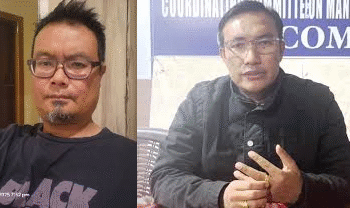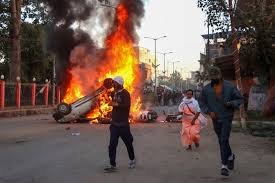N. Biren Singh’s 12-page memo to the Governor paints illegal immigration as Manipur’s biggest threat — yet it fails to address the brutal ethnic clashes that rocked the state, leaving over 260 dead and tens of thousands displaced. Critics say it’s a calculated deflection from governance failures.
BY PC Bureau
May 28, 2025 — Former Manipur Chief Minister N. Biren Singh has submitted an exhaustive 12-page memorandum to Governor Ajay Kumar Bhalla, urging him to continue the BJP-led state government’s efforts to identify and deport illegal immigrants from Myanmar and Bangladesh. The memorandum, submitted under President’s Rule, offers a wide-ranging account of demographic shifts, historical justifications, satellite data, and national security concerns.
However, as detailed and data-rich as it is, the document is striking for what it fails to address: the ethnic violence that unfolded under Singh’s leadership, which left more than 260 people dead, thousands injured, women raped, religious sites vandalized, homes razed, and tens of thousands displaced. While Singh frames illegal immigration as an existential threat to Manipur’s identity and security, he offers no acknowledgment or action plan for justice, rehabilitation, or accountability for the victims of the year-long conflict.
The Substance of the Memo: An Inward Fortress
In his memorandum, Biren Singh dedicates substantial space to constructing a historical foundation for his argument. He begins by tracing Manipur’s origins to around 30 AD through the royal chronicle Cheitharol Kumbaba, asserting that Manipur’s identity and territorial boundaries have been sovereign and distinct for centuries. He references colonial-era documents such as the Gazetteer of Manipur (1886), the Statistical Account of Manipur (1873), and the Anglo-Manipuri Treaty of 1762 to bolster his claim that
Manipur’s internal administration and land ownership traditions were respected even by the British.
READ The Entire memo of Biren Singh ( Pls copy the link and paste in your browser) https://drive.google.com/file/d/1Y_BgiX47GSFoJotvQCAQXrHbB7oWylM9/view?usp=sharing
—-
Singh uses this historical framing to argue that present-day demographic changes—particularly the growth of the Kuki-Zo population—are not a natural progression, but a distortion caused by infiltration.
The former Chief Minister also links the past to present administrative concerns, arguing that historical mechanisms like the Inner Line Permit (abolished in 1950 and reinstated in 2019 under the BJP) were originally designed to protect Manipur’s indigenous communities. He attributes demographic shifts and territorial encroachments to the absence of such protective frameworks, pointing to the dramatic rise in villages in Churachandpur and Kangpokpi districts as evidence of “coordinated demographic engineering.”
READ: Biren Singh Memo Sparks Debate: Hype or Hard Evidence?
Called on Hon’ble Governor, Shri Ajay Kumar Bhalla, at Raj Bhavan today. We had a detailed discussion on a range of pressing issues concerning the State, including issues regarding the Gwaltabi incident and to resolve the tensions arising from it.
We also had a talk on the… pic.twitter.com/1fuuSZ9Uxx
— N. Biren Singh (@NBirenSingh) May 27, 2025
By embedding his current concerns in a deep historical narrative, Singh positions his immigration crackdown as a continuation of Manipur’s age-old fight to preserve its identity—though critics argue this selective reading of history oversimplifies a far more complex and plural past.
Biren Singh’s memorandum spans centuries, starting from 30 AD, referencing the royal chronicle Cheitharol Kumbaba, British-era treaties, and colonial census records to assert Manipur’s historical sovereignty and the threat posed by recent demographic changes. Key elements include:
- Historical Sovereignty: Singh argues that Manipur’s boundaries and administrative systems have long been distinct, dating back to the pre-colonial era and reaffirmed in British gazetteers and treaties.
- Demographic Anxiety: He highlights that between 1881 and 2011, the population of what he categorizes as “new Kuki and Mizo groups” increased by 2505%, while Meitei and Naga growth remained under 900%. He links this growth to unchecked immigration from Myanmar and Bangladesh.
- Porous Borders and Refugee Influx: Singh blames military coups in Myanmar (1962, 1988, 2021) for mass inflows of Chin-Kuki migrants, describing a “demographic invasion” that he claims has destabilized the state and facilitated narco-terrorism.
- Illegal Settlements: He claims a deliberate manipulation of the 1972 Hill Areas Committee Order has allowed unauthorized village formation. Between 1972 and 2022, he states, villages in Churachandpur increased from 343 to 986, and in Kangpokpi from 186 to 793.
- Criminal Activity and Insurgency: The memo links illegal immigrants to narcotics cultivation, arms trafficking, and violence. Singh claims 40,000–1.5 lakh hectares have been used for illegal poppy cultivation by armed groups allegedly operating from Myanmar.
- Enforcement Actions: Singh outlines achievements during his tenure:
- Deportation of 93 Myanmar nationals in 2024–25 alone
- Destruction of 17,829 acres of poppy fields
- Drug seizures worth ₹9,300 crore
- Biometric registration of suspected immigrants
- Deportation of 29 ILP defaulters
- Policy Demands:
- Continued biometric verification
- Door-to-door survey of immigrants
- Legal clarification of the Hill Areas Committee’s powers
- A CBI probe into unauthorized village formation
- Extension of the 30-day MHA deadline for verification
 READ: BJP, Allies Meet Governor, Call for Restoration of Elected Government in Manipur
READ: BJP, Allies Meet Governor, Call for Restoration of Elected Government in Manipur
The Missing Chapter: Silence on Violence
Nowhere in the document does Singh mention the ethnic clashes that began in May 2023 and continued for months across the state. He does not acknowledge:
- The 260+ civilian deaths, including children and elderly
- The viral videos of women stripped, paraded, and gang-raped
- The burning of homes, churches, temples, and displacement of over 70,000 people
- The looting of more than 4,000 weapons from state armories
- The failure of police and paramilitary to protect vulnerable communities
- The persistent segregation of communities and breakdown of trust in state institutions
Singh, who was in power during the height of the violence, was widely criticized by opposition parties, human rights groups, and even some NDA allies for partisan governance, administrative collapse, and failing to act decisively when violence first erupted.
Despite this, his memorandum offers no apology, no roadmap for reconciliation, no compensation plan for the displaced, and no policy proposal for punishing those responsible for crimes committed during the riots.
Critics Speak: A Document of Deflection
“The document reads more like a campaign manifesto than a crisis response plan,” said a senior professor of political science at Delhi University. “Singh has shifted the entire focus from internal state failure to external blame. Illegal immigration may be real, but it is being used to overshadow an even more urgent truth: the collapse of rule of law and humanity in Manipur.”
Civil society leaders were even more blunt. “Where is the justice for the women who were gang-raped? For the children who saw their parents shot or hacked? For the people still in camps?” asked a spokesperson for the Kuki Women’s Union. “Not a single word. It’s like we don’t exist.”
Even Meitei human rights activists have voiced unease. “If you talk about Manipur’s future, you must first acknowledge its wounds. That’s not what this memo does—it whitewashes them,” said a lawyer who worked on relief efforts in Imphal.
Selective Memory, Selective Governance
By focusing almost entirely on illegal immigration and linking it to narco-terrorism and insurgency, Singh’s memo offers a reductive diagnosis of Manipur’s crisis—one that positions Kuki-Zo people as outsiders, erases the failures of his own administration, and forecloses meaningful dialogue.
Experts argue that this selective framing is politically expedient. It consolidates Meitei nationalist sentiment while deflecting from questions about administrative failure, law enforcement complicity, and community-level trauma.
The memorandum, instead of being a document of reckoning, is perceived by many as an attempt to rewrite the crisis as a foreign threat—not a result of fractured governance and deep-seated ethnic mistrust.
A Memo Without Moral Reckoning
- Biren Singh’s memorandum may be dense with citations, charts, and data points, but it is empty of human empathy. It names hills, rivers, villages, and insurgent groups, but not a single victim, survivor, widow, or orphan. It offers metrics, not mourning. Measures, not memory.
As Manipur continues under President’s Rule and looks toward a return to democratic governance, Singh’s document will no doubt be studied by central authorities. But unless it is accompanied by a serious reckoning with the human cost of the conflict, its legacy may be one of strategic omission—a history written without its most important characters: the people who suffered.














